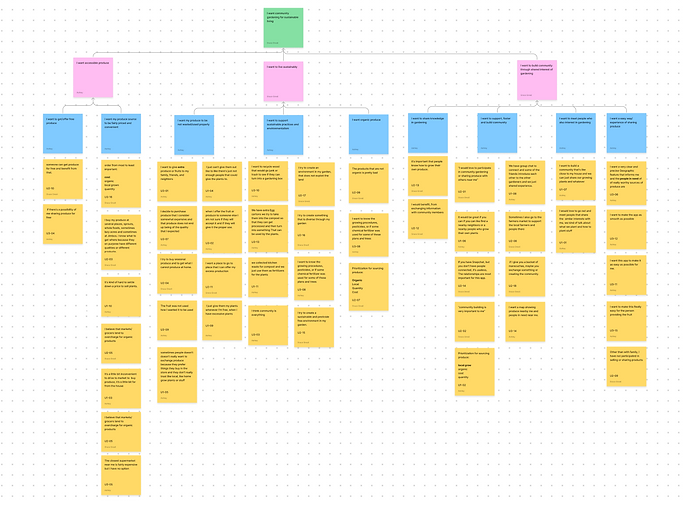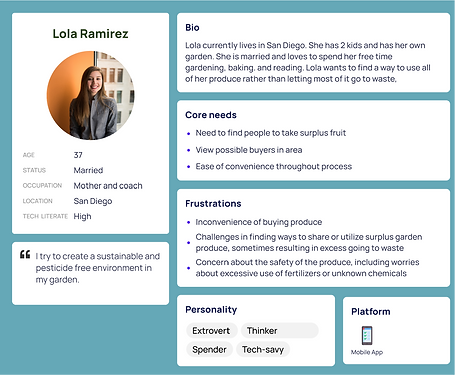
Producia
Community-driven produce-sharing app
THE PROBLEM
Currently there exists an inefficient way of produce sharing in our local communities. These current solutions lack community focus, resource optimization and sustainable practices.
TIMELINE
4 Months (Sep - Dec 2023)
MAKE OF THE TEAM
2 designers
TOOL
Figma
WHO IS OUR AUDIENCE?
Our intended user group of the Producia application includes community members aged 18+ who have an interest in gardening, outdoor activities, farmers' markets, and nature-related experiences.
MY ROLE
I contributed to the overall design process, including overseeing product scoping and related aspects. Moreover, I conducted user research and competitor analysis, and generated design concepts using personas, storyboards, user flows, wireframes, paper prototyping, High-fidelity prototyping and usability testing.
COMPETITIVE
ANALYSIS
Apps that currently offer a solution include:
-
FaceBook marketplace
-
Offer Up
-
Olio App
-
Galora App

INTERVIEWS AND ANALYSIS
INTERVIEW NOTES
● Interviewed 3 people, ages 10-51 years of age
● Each interview was between 15-30 minutes in duration
ADDITIONAL NOTES (Post interview reflections):
● All interviewees mentioned being comfortable with technology and regularly uses gardening-related mobile apps. This suggests a potential user who is tech-savvy.
● Interviewee #3 highlighted the importance of community building through gardening. They showcased a desire for using the app to connect with like-minded individuals and foster local connections.
● Interviewee #2 demonstrated a strong interest in sustainable gardening practices. They expressed the desire for the app to provide tips on eco-friendly gardening methods.
AFFINITY DIAGRAM

THEMES AND TAKEAWAYS
Some of the key takeaways from our affinity diagram include the following pink slips:

Other key takeaways from the interview include:
● Our users desire a way of connecting with others in their community through sharing/selling produce with others
● Our users desire a safe and secure platform that is transparent with how the produce was grown and if there was pesticide usage
● Our users desire a user interface that displays nearby produce/ individuals looking for specific items
● This application has the potential to increase and foster community
● This application has the power to increase sustainable practices and limit food wastage ( which is also a desire and goal of our users!)
NEEDS FINDING
USER PERSONAS


STORYBOARDS

NEEDS FINDING
USER FLOWS


In order to gain a more comprehensive understanding of our users' experience, we created user flow diagrams. These diagrams serve as visual representations that outline the step-by-step journey users undertake when interacting with our product. We focused on two key features: the 'Add Listing' flow and the 'Search for an Item' flow. By mapping out these processes, we aimed to uncover insights into the user's journey, ensuring a thorough comprehension of their experience from initiation to completion within.
INITIAL PAPER PROTOTYPES


We made paper prototypes based on our 2 flows, the add listing flow and the searching an item flow.
Using initial paper prototypes in our design process was instrumental for our application.
This allowed us to rapidly iterate, gather early user feedback, and promote collaborative design.
USER TESTING
UF1: User Flow for Listing a Produce Item:
Commonalities:
-
Both tech-savvy and less tech-savvy users found the initial steps of listing a produce item straightforward.
-
Clear labels and an intuitive interface were appreciated by both user groups.
-
Moderately tech-savvy users had no significant issues and completed the task successfully.
Key Findings:
-
Some aspects of the listing process, particularly photo cropping, were still confusing.
-
Struggles were observed in understanding and using certain features like location filters.
-
Potential pain points include difficulties with image manipulation and complex filters.
Potential Solutions:
-
Provide more user guidance or tooltips for actions like photo cropping
-
Simplify or make advanced features like location filters optional
-
Continue to improve the user experience for individuals with limited tech proficiency.
UF2: User Flow for Searching with Filters: Commonalities:
-
Both user groups, including tech-savvy graduate students and less tech-savvy users, found the filter system to be user-friendly and effective.
-
The user flow for filtering by category, price, and location seemed straightforward for both groups.
Key Findings - Pain Points:
-
Less tech-savvy users may struggle with understanding whether their selected filters are active (also may be fault of paper prototype due to its limitations)
-
A lack of clear feedback regarding active filters could lead to potential frustrations.
Potential Solutions:
-
Provide clear feedback to users about the status of their selected filters.
-
Consider adding visual cues or indicators to confirm filter application.
WIREFRAME - FigJam


DESIGN LANGUAGE + PATTERNS



HIGH FIDELITY PROTOTYPING
ADD LISTING FLOW

SEARCH FOR AN ITEM FLOW

TITLE OF THE CALLOUT BLOCK
LESSONS LEARNED
I am so grateful to have been part of an amazing team. Reflecting on the design project for my first user-centered design class, I've come to appreciate the intricate balance between user needs and sustainable practices. Throughout the process of creating a community-driven gardening and produce-sharing mobile app, I learned the importance of aligning the product with the genuine interests and activities of potential users.
Engaging with local gardening enthusiasts not only provided critical insights but also highlighted the app's role in reinforcing local bonds and promoting shared sustainable values—a lesson that underscores the profound impact of thoughtful design on community building. This experience taught me the importance of grounding design in real-world user experiences to create solutions that are both practical and meaningful.